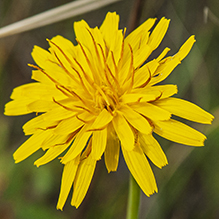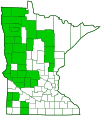pale agoseris
(Agoseris glauca var. glauca)
Conservation • Wetland • Description • Habitat • Ecology • Use • Distribution • Taxonomy
Description |
Pale agoseris is a common, erect, perennial forb that appears as a rosette of basal leaves and a single flowering stalk (scape). It rises from a taproot and occasionally a branched thickened swelling of the base of the scape (caudex). It can be up to 36″ tall in areas with a long growing season, but in Minnesota it is usually 8″ to 18″ in height. The leaves are stalked, linear lance-shaped to inversely lance-shaped, 2″ to 12″ long, and 1⁄32″ to 1 3 ⁄16″ wide. They may be erect or recline on the ground with the tips ascending. The leaf stalks (petioles) may be erect or lay flat on the ground. They are not purple. The leaf blades are long-tapered to a point at the tip. The upper and lower surfaces are hairless or nearly hairless and somewhat covered with a whitish, waxy substance (glaucous). The margins are unlobed and flat, not wavy. Most leaves are untoothed though some may have a few scattered shallow teeth. The midvein is pale green and conspicuous. The inflorescence is a solitary, medium-sized flower at the end of a single flowering scape. The scape is usually 8″ to 18″ in height. It is leafless and usually hairless, but sometimes minutely hairy near the top. There are no stalked glands on the scape. The flower head is 1″ to 2″ wide. The whorl of modified leaves (bracts) at the base of the flower head (involucre) is inversely cone-shaped or bell-shaped. It is ⅜″ to ¾″ long in flower, ⅜″ to 1 3 ⁄16″ long in fruit. It is composed of 10 to 50 overlapping bracts (phyllaries) in 2 or 3 series. The phyllaries are sharply pointed and green. They sometimes have a reddish-purple median stripe. They often have purplish-black spots on the surface and purplish-black tips. The flower head has 15 to 50 ray florets and no disk florets. The strap-like portion of each ray (ligule) is ¼″ to 1″ long, 1 ⁄16″to 3 ⁄16″ wide, and has 5 teeth at the tip. The flowering season is May to September but the flowering period of individual plants is short. The fruit is a dry, one-seeded seed capsule (cypsela). The cypsela is ribbed, narrowly cone-shaped, and ¼″ to ⅝″ long. It tapers to a stout, 1 ⁄32″ to ⅛″ long, prolonged tip (beak). The beak is usually less than half as long as the body. There is a tuft of 15 to 125 white, 5 ⁄16″ to 11⁄16″ long barbed bristles (pappi) attached at the end of the beak. |
Height |
8″ to 18″ |
Flower Color |
Yellow |
Similar Species |
Prairie false dandelion (Nothocalais cuspidata) is a shorter plant, no more than 13¾″ tall. The leaf margins are often, but not always, wavy. It is found on dry prairies in sandy or gravelly soils. |
Habitat |
Wet. Moist prairies, meadows, wetland edges, stream margins, and swales. Silty soil, clay, and other fine-textured soils. |
Ecology |
Flowering |
May to September |
Pests and Diseases |
|
Use |
|
Distribution |
||
|
Sources |
|
| 5/24/2023 | ||
Nativity |
||
Native |
||
Occurrence |
||
Common |
||
Taxonomy |
|
Kingdom |
|
Division |
Tracheophyta (Vascular Plants) |
Subdivision |
Spermatophytina (Seed Plants) |
Class |
|
Order |
Asterales (Sunflowers, Bellflowers, Fanflowers, and Allies) |
Family |
Asteraceae (Sunflowers, Daisies, Asters, and Allies) |
Subfamily |
Cichorioideae (chicories, dandelions, and allies) |
Tribe |
Cichorieae (lettuce, chicory, dandelion, and salsify) |
Subtribe |
Microseridinae |
Genus |
Agoseris (mountain dandelion) |
Species |
Agoseris glauca (pale agoseris) |
Subordinate Taxa |
|
|
|
Synonyms |
|
| Troximon glaucum | |
Common Names |
|
| pale agoseris | |
Glossary
Beak
A comparatively short and stout, narrow or prolonged tip on a thickened organ, as on some fruits and seeds.
Bract
Modified leaf at the base of a flower stalk, flower cluster, or inflorescence.
Caudex
A short, thickened, woody, persistent enlargement of the stem, at or below ground level, used for water storage.
Cypsela
A dry, one-chambered, single-seeded seed capsule, formed from a single carpel, with the seed attached to the membranous outer layer (wall) only by the seed stalk; the wall, formed from the wall of the inferior ovary and also from other tissues derived from the receptacle or hypanthium, does not split open at maturity, but relies on decay or predation to release the contents.
Glaucous
Pale green or bluish gray due to a whitish, powdery or waxy film, as on a plum or a grape.
Involucre
A whorl of bracts beneath or surrounding a flower, flower head, or flower cluster.
Ligule
In grasses, a membranous appendage at the junction of the leaf and the leaf sheath, sometimes no more than a fringe of hairs. In flowering plants, the flat, strap-shaped, petal-like portion of the corolla of a ray floret.
Linear
Long, straight, and narrow, with more or less parallel sides, like a blade of grass.
Pappus
The modified calyx composed of awns, scales, bristles, or feather-like hairs in plants of the Asteraceae family.
Petiole
On plants: The stalk of a leaf blade or a compound leaf that attaches it to the stem. On ants and wasps: The constricted first one or two segments of the rear part of the body.
Phyllary
An individual bract within the involucre of a plant in the Asteraceae family.
Scape
An erect, leafless stalk growing from the rootstock and supporting a flower or a flower cluster.
Visitor Photos |
||||
Share your photo of this plant. |
||||
| This button not working for you? Simply email us at info@MinnesotaSeasons.com. Attach one or more photos and, if you like, a caption. |
||||
|
||||
MinnesotaSeasons.com Photos |
||||
|
||||
|
|
|||

Slideshows |
Agoseris glauca |

|
About
Native perennial herb 8-50 cm tall, flower heads scapose, rays yellow, pappus of capillary bristles, achenes beaked, common in grasslands, sagebrush steppe, meadows, from low to high elevations. |

Visitor Videos |
||
Share your video of this plant. |
||
This button not working for you? |
||
|
Other Videos |
||
|

Visitor Sightings |
||
Report a sighting of this plant. |
||
This button not working for you? |
||
|
|
MinnesotaSeasons.com Sightings |
||

|
Created: 10/24/2013 Last Updated: © MinnesotaSeasons.com. All rights reserved. |

